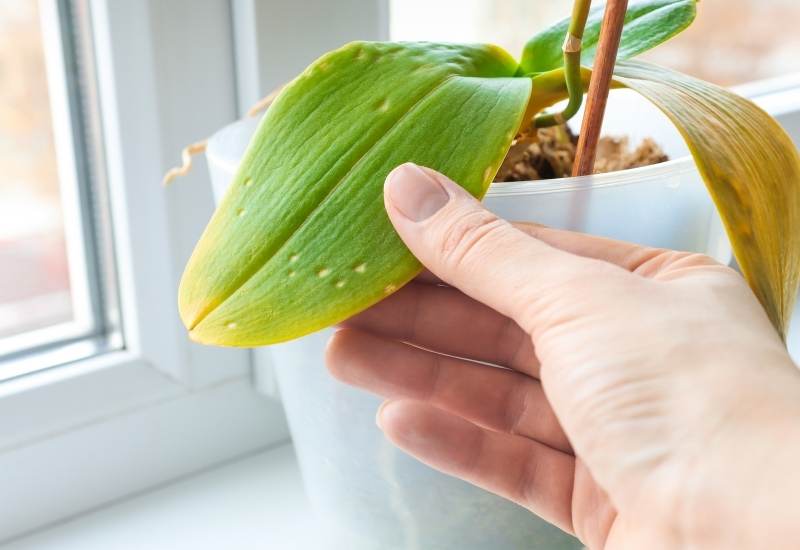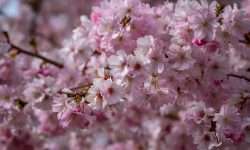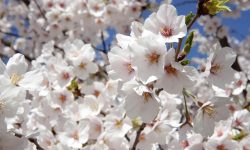Orchids are one of the most popular houseplants, and for good reason. They’re beautiful, they’re easy to care for, and they come in a wide variety of colors and shapes. But sometimes, Orchid leaves turn yellow.
If this happens to your plant, don’t worry—it’s not necessarily a sign that something is wrong. There are a few different reasons why Orchid leaves turn yellow, and we’ll go over them all here.
If your orchid’s leaves are turning yellow, it could be a sign that the plant is not getting enough light. Orchids need bright, indirect sunlight to thrive, so if yours is not getting enough light, the leaves will start to turn yellow. Another reason for yellowing leaves could be over- watering.
Be sure to check the soil before watering and only water when the top inch of soil is dry. Too much water can cause root rot, which will also lead to yellowing leaves. If you think your orchid is getting too much or too little water, take a look at the roots.
Healthy roots should be white or pale green in color. If they’re brown or mushy, that’s a sign of root rot and you’ll need to take action quickly to save your plant.
Yellowing leaves on an orchid can also be caused by a nutrient deficiency.
If your plant isn’t getting enough nitrogen, phosphorus, or potassium, the leaves will start to turn yellow. Check your fertilizer labels to make sure you’re giving your orchid the nutrients it needs and adjust accordingly if necessary. Finally, temperature stress can also cause orchids’ leaves to turn yellow.
Orchids prefer temperatures between 70-85 degrees Fahrenheit during the day and 60-70 degrees at night.

Credit: www.gardeningchores.com
What Do You Do When Orchid Leaves Turn Yellow?
Orchids are a tricky plant to keep alive, and even if you’re doing everything right, sometimes their leaves will turn yellow. While it’s not always a bad sign, it can be an indication that something is wrong. Here are a few possible reasons why your orchid’s leaves might turn yellow:
1. The most common reason is simply that the plant is getting too much sun. Orchids like bright light, but not direct sunlight. If you notice the leaves turning yellow, move the plant to a spot with indirect light and see if that helps.
2. Another possibility is that the plant is getting too much water. Orchids like to be kept on the dry side, so make sure you’re not over-watering it. Let the potting mix dry out completely between waterings and don’t water more than once a week.
3. Nutrient deficiency can also cause yellow leaves. Make sure you’re fertilizing your orchid regularly (about once a month) with a balanced fertilizer made specifically for orchids.
4. Sometimes, yellow leaves are just unavoidable – they happen as part of the natural aging process of the plant and aren’t necessarily an indication of anything being wrong.
What Causes Orchids to Get Yellow Leaves?
One of the most common reasons why orchids get yellow leaves is due to a lack of water. When the plant doesn’t have enough water, the leaves will start to turn yellow and eventually drop off. Other causes of yellow leaves on orchids include too much sun, too much fertilizer, pests, and diseases.
If you notice your orchid’s leaves turning yellow, it’s important to try to figure out what the underlying cause is so that you can take steps to fix it.
How Often Do I Water My Orchid?
If you’re wondering how often to water your orchid, you’re not alone. Many people struggle with this question because it can be difficult to know when your plant needs hydration. The best way to determine how often to water your orchid is to check the soil regularly and water when the top inch or so of soil feels dry.
However, keep in mind that every plant is different and some may need more (or less) water than others. Additionally, the frequency of watering will also change depending on the time of year and the climate where you live. In general, watering once a week should be sufficient, but be sure to adjust as needed based on your specific plant’s needs.
Best 15 Orchid Leaves Turning Yellow Causes, How To Save Orchid With Yellow Leaves #OrchidPlantCare
Should You Cut off Yellow Orchid Leaves
Orchids are a beautiful and popular type of flower, but they can be finicky to care for. One common issue that orchid owners face is what to do about yellow leaves. So, should you cut off yellow orchid leaves?
The simple answer is yes, you should cut off yellow orchid leaves. However, there are a few things to keep in mind before you start trimming away.
First, it’s important to understand why your orchid’s leaves are turning yellow.
It could be due to a number of reasons, including stress from too much sun or water, pests, or disease. Once you’ve determined the cause of the yellowing leaves, you can take steps to correct the problem and prevent it from happening again in the future.
Second, not all yellow leaves need to be removed.
If only a few leaves are affected and the rest of the plant looks healthy, you may not need to do anything at all. In fact, removing too many leaves can actually harm your orchid by disrupting its growth cycle.
Finally, when cutting off yellow leaves, be sure to use sterilized scissors or shears.
This will help prevent the spread of any diseases that may be present on the affected leaves.
So there you have it – everything you need to know about whether or not to cut off yellow orchid leaves!
Orchid Leaves Turning Yellow And Flowers Falling off
If you notice that your orchid leaves are turning yellow and the flowers are falling off, it’s important to take action quickly. There are a few possible causes of this problem, so it’s important to diagnose the issue correctly.
One possibility is that your orchid is getting too much sun.
Orchids need bright light, but too much direct sunlight can cause the leaves to turn yellow and the flowers to fall off. If you think this might be the problem, move your plant to a shadier spot.
Another possibility is that your orchid isn’t getting enough water.
Orchids need to be watered regularly, but if they’re not getting enough moisture, the leaves will turn yellow and the flowers will fall off. If you think this might be the problem, water your plant more frequently.
Finally, it’s also possible that your orchid is suffering from a nutrient deficiency.
If the leaves are yellowing and the flowers are falling off, it could be a sign that your plant isn’t getting enough nitrogen, phosphorus, or potassium. You can solve this problem by fertilizing your orchid with a balanced fertilizer designed for use on flowering plants.
Phalaenopsis Lower Leaves Turning Yellow
If you’re growing Phalaenopsis orchids and notice the lower leaves turning yellow, don’t worry – this is perfectly normal! The older, lower leaves of a Phalaenopsis orchid will naturally turn yellow and eventually fall off as the plant grows. This is part of the plant’s natural life cycle and nothing to be concerned about.
There are a few things you can do to help keep your Phalaenopsis healthy and prevent yellowing leaves: make sure it’s getting enough light (but not too much), water it regularly, and fertilize it monthly with a balanced fertilizer. If you follow these simple care instructions, your Phalaenopsis should stay healthy and vibrant for years to come!
Does Leaf Yellowing in Orchids Lead to Leaf Curling?
Leaf yellowing in orchids can indeed lead to leaf curling. One of the main orchid leaf curl causes is a deficiency in nutrients, particularly nitrogen. Lack of moisture and incorrect watering practices can also result in leaf yellowing and subsequent curling. Additionally, exposure to extreme temperatures, pests, or diseases can contribute to this issue. It’s crucial to address these factors promptly to prevent further damage to the orchids’ foliage.
Orchid Bottom Leaves Turning Yellow
If you notice that the bottom leaves of your Orchid are turning yellow, this is most likely due to a lack of water. The best way to resolve this issue is to water your Orchid more frequently. Make sure that you are using room temperature water and that you are not over or under watering your Orchid.
If you think that you may be over watering your Orchid, allow the soil to dry out completely before watering again.
Conclusion
If you notice that your orchid’s leaves are starting to turn yellow, don’t panic! There are a few reasons why this may be happening, and it is usually nothing to worry about. The most common reason for yellowing leaves is simply due to the plant getting too much sun.
Orchids like bright light, but not direct sunlight, so if you think this may be the problem, try moving your plant to a spot that gets indirect light. Another possible reason for yellowing leaves is over-watering. Orchids need to be watered about once a week, and if you are watering them more often than that, they may start to show signs of stress like yellowing leaves.
Finally, sometimes orchids just naturally produce yellow leaves as they age. If your plant looks healthy otherwise, there is no need to worry about a few yellow leaves.






